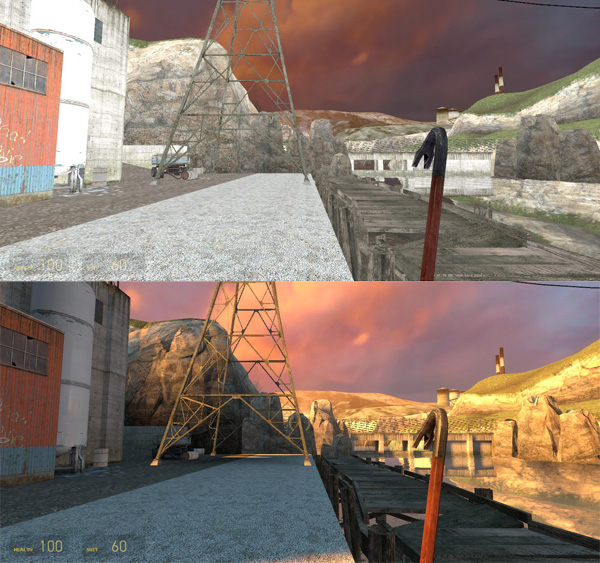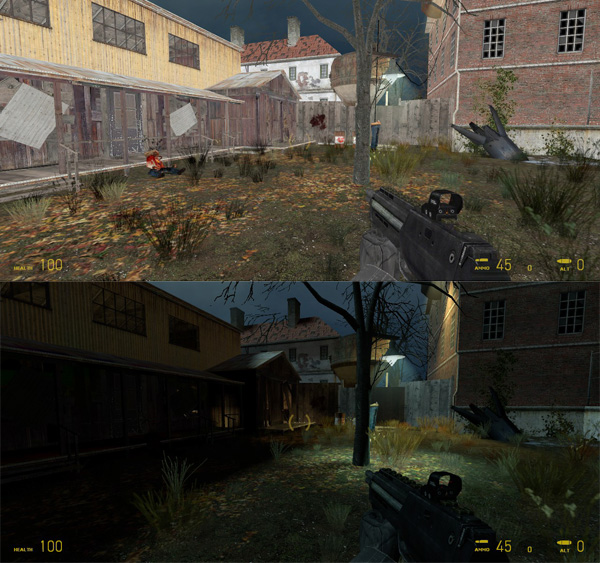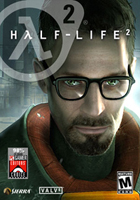
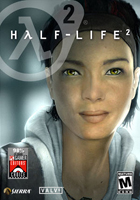
 (Collect all 3 covers!)
(Collect all 3 covers!)
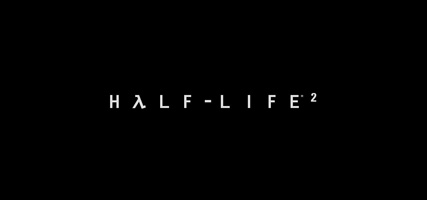
Half-Life 2
developed by Valve (Bellevue, WA)
first published November 16, 2004 by Vivendi Universal Games (retail) and Valve (online), for Windows, $49.95 [original site, current site]
~3.5 GB
Played to completion in 17 hours, 1/3/15–1/6/15
[Video of a complete 9-hour playthrough in five parts: 1, 2, 3, 4, 5. Unlike me, this guy has turned on subtitles, which you should ignore.]
[The 1-minute official trailer]
So now that I’ve gotten “The Half Life 1 Anthology” out of the way, I can go back to the beginning of my list, to 11/28/10, when I purchased “The Orange Box” on sale for $7.50 because I wanted Portal and figured the other games couldn’t hurt. That was five games at $1.50 apiece. The other four of which I am only getting to now.
On all the “best game ever” lists, Half-Life 2 is right up there.
At first blush, the reason is obvious: this is a truly incredible advance on what had ever come before, an astounding masterpiece, oh my god you have to see this. And then once the game is done, it can be that again, because one has learned exactly what it is and isn’t, and can get to work on loving it the way it wants. In between comes the business of actually wrangling with it, as it presents itself to you for the first time. That should be what counts most, shouldn’t it? I don’t know, maybe it shouldn’t. But that’s what I took notes on. Here they are.
This first note is something I already said about that lavish remake of the original Half-Life. Now I’m going to say it again at greater length:
Games with lots of detail feel like they’re chiding me for liking the senses too much when a given detail turns out to be inconsequential or false. “Hey, look at those beautiful rocks, let’s go see if we can climb on them… oh, seems like they’re not really meant to be looked at up close. Oops, I guess I was wrong to get so enthused about this; I was supposed to see it as mere decoration. But hey, look at that beautiful tree!… oops…” A rationalized/formalized/computerized model of the world that purports to incorporate all sensory richness, but only as a kind of fancy-dress makeup, is a much more distressing formalism than the barer, more primitive models that came before. The autistic abstraction of conceiving of human endeavor in terms of HP and XP is far more palatable in the abstract spaces of a tabletop game than when one is exploring a fully visualized world. The philosophical gap of the nerds becomes more treacherous the more of the human experience they have it devour.
Games today (and computerizations generally, which one could take to include Facebook et al.) bite off more than they should chew, or, to put it more frighteningly, chew and swallow more than their fair share of existence. There is a beautiful sunset in this game, but only in the set-dressing sense. What about everything else that a beautiful sunset is? The game and its programmers say, “Quantify that, kid, and we’ll eventually try to put it in. If you can’t quantify it, it doesn’t exist.” Ouch!
I’m someone who rejects that philosophical line, so this game and its many progeny (i.e. the entire past decade of increasingly photorealistic 3D environments) fall into a philosophical ‘uncanny valley,’ for me. The old puppet-show mimesis hasn’t changed, it’s just been tarted up with a tinsel naturalism that is seductive yet overwhelmingly empty. You can always see so much more than there is. Look but don’t touch. Or, in this game’s case: Touch (“Oh my god, you can pick up and move any object in the game world!”), but don’t feel (“Oh my god, all these diverse and evocative objects are identically useless hollow shells!”)
It all gives me the feeling of being right on the knife-edge between welcome and unwelcome. It’s kind of a subtly seedy feeling, like Pleasure Island; the mixed messages of a surly carny: “Come one come all! Have a great time! All your fantasies come true! Hey! Get your dirty mitts off that, kid! Scram!” I guess that’s overstating it; it’s not that this game ever says “Scram,” it just gets sort of shifty and uncommunicative when you start to stray, even though it seems to be inviting you to stray.
Put another way: where Half-Life felt like a warm invitation to see the show they were putting on just for you, Half-Life 2 has an underlying spirit of showing off. Which is a little more of a rigid, brittle thing to encounter, socially. (But, like I said, once you’re done and have seen the whole thing, you’ve learned its needs, and how to get its forgiveness. “Yeah, it was silly of me to want to climb on those rocks! That was out of line; I totally agree, game. Let’s make up! I promise never to doubt you again, you amazing queen bee, you.”)
Under all the lacquer, it’s the same game as last time, and the dramatics have not been advanced on. I said that Half-Life‘s strength was that it was what it was. This is less consistently what it is; the watching and the doing are less synchronous than they had been. The seductive ambition has here somewhat outstripped the dramaturgical ambition; these are the same storytelling devices, just given new flash. But luxury — and this game is undeniably luxurious — is not a substitute for rightness. When you (“Gordon Freeman”) are being welcomed back by friends, brought into the fold of an underground resistance movement, sent on desperate rescue missions that other people plan and describe to you in advance, there is a real social gap between what the player is doing and what the drama says is going on.
I wrote the preceding paragraph when I was about halfway through the game. Now that I’m done I must say that later in the game it gets much closer to the mark. For the last third of the game (or so), you’re put on a meandering cinematic path through a landscape of chaotic urban warfare, while a battle gradually progresses around you. This section is, like the first game, splendidly congruent with the player’s experience: I must make my way through this dream as it unfolds. The four hours I spent in that sequence were the highlight.
Now, if you had described the various chapters to me in advance I would never have guessed that I’d like the military action bit most of all, because that’s just not my thing. And yet I did, because it had the most flow. Flow above all; flow outweighs content.
My enjoying these games at all is fair evidence of that, because they continue to be full of content that I find unappealing. This time, in addition to continued zombie gore, I have big-picture doubts too: Is this depressing end-of-the-world scenario really any fun? Are “fight the power” “big lie” dystopia stories really so enticing? (Does Katniss Everdeen shit in the woods? (Yes.)) Luckily, unlike, say, Snowpiercer, this game doesn’t really have any political ideas up its sleeve; it’s just shuffling the genre deck to give us a ride. That’s bad because it means nothing rings particularly true or false, but good because I don’t actually have to argue with it. When we get to the payoff and finally see inside the alien tower, I felt a suitable sense of excitement at having earned my way to the zone of elite revelation, without having to give any meaning to that revelation. Whereas when whatsisname got to the front car of the Snowpiercer, into that same space of rarefied ultimateness, inner-sanctum-ness, endgame, I felt the space burdened with a lot of resentment. Here it was just, you know, stuff borrowed from The Matrix, which by 2004 everyone had seen. Nobody hesitates to take the red pill when they know it’s just for fun. I knew all this War Of The Worlds bleakness was just for fun, even though I probably wouldn’t have ordered it.
While I’m on the subject of endgame, I want to note that the bad guy in Half-Life 2, Dr. Breen, is really nicely written and performed, well beyond the usual videogame standard. He’s confronted in person at the end, but seen and heard throughout the game on video screens. The character looks and sounds like Dennis Hopper so I figured that’s who it was, but it’s not; it’s in fact Robert Culp (with the face of just some guy). So kudos to Robert Culp, for his class and intelligence in bringing a weird computer fantasy puppet person to a surprising semblance of life (even though he does pronounce “fungi” as “foon-jee,” which seems wrong to me). And RIP. (You too, Dennis Hopper.)
The storytelling generally is in that awkward middle space, somewhere between serious investment and gleeful indulgence of cliché-as-cliché, that characterizes and hobbles so much “genre fiction” in my view. The first game, as I’ve said twice already, fell almost entirely in the category of cheerful, almost parodic familiarity, and was stronger for it; this one has almost no note of parody. It seems to want to feel genuinely eerie and grim, which in places was hard for me to wrap my head around. This is all just a goofy excuse to play a game, right? Maybe that’s just another form of being a brittle show-off. But I think it stems from deeper questions of worldview; this is by and for people who take a lot of that grimness for granted and know exactly what emotional slot to put it in.
I can say at least that the horror of being in an alien tower of steel is more meaningful to me than the horror of being in a fleshy womb that the last game offered. So many possible hangups to exploit! I think my ideal endgame would be a horrifying stack of homework with a teacher alien yelling at you to do it faster.
There is one chapter of this game that deliberately feels like it’s from another game entirely: a full-on horror-movie sequence of zombie slaughter that lasts for a couple hours. Zombies aren’t really my cup of tea and I was glad to get out of there.
I’m able to appreciate Halloween-y scares even if I don’t relish them. But there is one thing to which I genuinely object: the zombies cry out in anguished demi-human voices as you slaughter them. To me, the least healthy aspect of the zombie-mania of the last decade (which is finally waning?) is the emphasis on mercy killing. If, as I said a few entries ago, blowing up horrors in a game is the performance of repression, then mercy-killing pathetically human horrors is self-congratulation for ignoring the pain that it causes. These zombies scream like people in pain so that you’ll feel sickened, and then confront your reservations with resolution: “Well, the fact is that it was too late for them; I put them out of their misery. That it is upsetting to hear their screams is what makes this the gratifyingly hard work of an adult.” This translates to repression of doubts about repression: “Yes, that part of me cried out ‘I’m innocent, don’t repress me!’ when I went to repress it, and sure, that’s hard to hear, but that’s what makes me truly mature, that I steel myself and do it anyway.” Instead of “if you love it, set it free,” this is “if you love it and you’re a man, kill it quickly.” This is a long-running motif in pulp culture and I really don’t approve.
The game may seem very open but it’s actually a lot like a “rail shooter,” one of those light-gun shooting gallery arcade games, where the camera moves are fixed and unstoppable (“on rails”) and the player progresses through the story automatically as long as he/she manages to hit all the pop-up targets, which is the only actual task. Yes, obviously Half-Life 2 differs in that it affords you full control of your movement and all sorts of other freedoms, but it’s stage-managed the same way those games were, it has the same kind of story flow.
In light-gun games, the story was always a flimsy pretense, but at the same time it was also the entire form of the game and served as its driving force. Again I think of Disney rides. The principle is the same as with, say, the Indiana Jones ride: you don’t really pay attention to the ride lore, the quasi-story about the curse of the Temple of the Forbidden Eye; everybody understands that stuff to be weak obligatory hokum… and yet everybody also willingly registers it, because it is crucial to the premise of the ride experience, which is that something is happening while you are on it. Likewise, I say, Half-Life 2 doesn’t offer real drama; it is just offering you something that is happening while you play it, an obligatory pretense for the shooting gallery. It just so happens that what it offers as its pretense is so exceptionally cared-for and intelligent and three-dimensional, goes so far beyond the call of duty, that one can become confused about what one is dealing with. And that confusion becomes a part of the experience of overwhelming impressiveness. But ultimately the only way I found of enjoying it unequivocally was just as an astoundingly fancy ride, slightly monotonous, filled out with astoundingly fancy ride-lore hokum.
This somewhat answers my itchiness about the level of detail. Those rail shooter arcade games are all very pure dreams, where, exactly because there’s no freedom, it’s clear that everything apart from the targets is mere atmosphere, wonderfully so. Those are incredibly decadent games. So is Half-Life 2, but only on the second time through, when one knows exactly what’s what.
Having a character tell you “You’re going to have to take the dune buggy up the coast now!” makes perfect sense in a pre-ordered dream-logic sequence, a kind of sense that it doesn’t make to me as an individual with freedoms. Maybe that’s only because I’m personally too nervous to accept the flow and trust it when it’s so lightly imposed. I’m very happy with its flow until I lose the thread, and whose fault is that? Seems like that’s exactly the game’s responsibility. But maybe I’m only losing the flow in the first place because I’m such a worrier. I carry these same anxieties with me everywhere, after all.
Maybe if I were a more trusting person, it would never have occurred to me to want more out of a rock or a tree in the scenery because I would have been so in the zone, socially melded with the game. Maybe all that “look but don’t touch” angst about the stuff on the periphery is really just a product of my issues with distrusting the game whenever it comes out and says “touch! touch this! it’s great!”
I tend to worry about missing stuff as I go through games, always looking around to make sure I’ve got all the information before I make a choice, rather than going with the obvious and gobbling up what’s right in front of me, despite the fact that this tends to break the chain of communication between the game and me. This is the same form of unacknowledged anxiety as the impulse to save the most appealing food on the plate for last, which I have done since childhood. Eventually that habit developed an additional kink, so that I would save the last bite of the most appealing food for later but not for absolutely last because that was itself too on-the-nose. Instead have it nearly last. And then further kinks on that, always seeking the periphery instead of the center.
I am certainly not the only game-player with these sorts of anxiety problems, though, and to my dismay Valve directly feeds the flames: there are “achievements” built into this game, which is to me a hateful way of bundling OCD into the thing itself. It’s one thing for people to make up their own games of crazy missing the point, but for the game itself to say “We have a badge for you if you can do chapter seven standing on your head!” cuts directly against its duties as a game. There are marketing reasons for online gaming platforms to have such stuff in them, but not internal aesthetic reasons. It’s like if you went to see a new movie and as you were taking your seats, the usher handed you a pamphlet that said “Can you count the number of times that people say ‘Fred’ in the movie? Write your answer here for a prize!” Dammit, you just ruined the movie.
So in this respect the game has a note of unhealthiness in it. But I am deepening my conviction that games are generally good for the mind. Fantasy is valuable because the mind that fantasizes can only be our true self. Being our false self in investing in another explicitly false self is simply too hard, like Mel Blanc doing Bugs Bunny doing Daffy Duck, a clip that I cannot find at the moment.
About two thirds of the way through the game it struck me that areas that ought to be dark weren’t really very dark and that I hadn’t used my flashlight in a very long time. I googled and found that there’s some kind of bug that’s been in the game since an update in 2010, where after a certain point the game starts rendering by default in “fullbright” mode. There was a simple fix for this that I immediately applied. Turned out that where I had seen the top image, I should have been seeing the bottom:
Yikes! That’s some 8 hours of gameplay that I had to reconsider. I was struck by how completely this difference in lighting affected all my opinions of the game. My issues with detail and flow seemed in part answered by all the cues I’d been missing in the lighting design (e.g. that the shore across the water is bathed in yellow sunset light makes it far clearer that it is merely scenery and not to be explored. The spots of sunlight catching on the rock outcropping at left call one’s attention to the gap between it and the building, which is in fact where one needs to go next.) I felt a little cheated. Did I need to go replay those whole sections of the game again? That would be a lot of game to revisit!
Then again, in the zombie section I had seen the top image, instead of the bottom:
I had thought the creepy flat lighting was plenty scary, when in fact I was supposed to be making my way through a thick midnight darkness. See that zombie lying against the porch, who will later get up and surprise you? Not in the real lighting, you don’t! That settled it for me: I wasn’t going to replay.
But again, note what a huge difference in meaning there is just from the application of lighting to the same exact game content. “Meaning” in a game is very holistic; there’s no separating the essential from the inessential. While I might sound like I’m talking about “gameplay” choices, or “graphics” choices, I’m really always talking about everything at once, mutually interacting and combining in ways that nobody could ever completely plan or name. That it looks just so while sounding just so and reacts just so makes for a certain just-so-ness that transcends any simple creative intentions. This mysterious synthesis is what computer games offer so particularly richly.
To return to its “greatest game ever” status: Yes, this is a very very luxurious piece of computer-gamery, designed to impress, and it absolutely did. At times it gave me a touch of the thrilling feeling that I had a game better than I’m supposed to have, like in childhood dreams where the toy I most wanted turned out to have been in a cupboard downstairs all along. This is a cool-kid game for cool kids. But if you’re nice they’ll let you play it anyway, as long as you agree to say that it’s the awesomest.
Where Half-Life credited 30 people, this one credits 84. As far as I can tell, the core staff is almost exactly the same, with the addition of art director Viktor Antonov, whose contribution is pretty substantial.
Here’s a behind-the-scenes article that parallels the one from Half-Life. Various in-house presentation slides can be browsed here, including some of technical and some of general interest.
